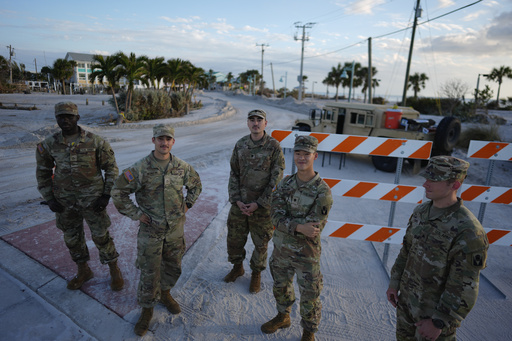
Florida Residents Face New Challenges After Dual Hurricanes
VENICE, Fla. — Just as the inhabitants of the Bahia Vista Gulf condominium complex began recovering from the devastation caused by Hurricane Helene, they were met with the daunting aftermath of Hurricane Milton, which caused widespread destruction shortly thereafter.
The beachfront units had undergone extensive cleaning, treatment, and drying after the first hurricane, with piles of sand that had invaded the property removed. However, the arrival of Hurricane Milton, less than two weeks later, reversed all the recovery efforts made. Bill O’Connell, a board member of the complex, expressed frustration, stating that the entire cleaning and restoration process must now be restarted due to the storm’s impact, as it brought back the sand that had just been cleared.
Longtime Floridians have grown used to the seasonal storms that can significantly disrupt lives in a state characterized by its pleasant climate, sunny days, and beautiful beaches. “It’s the price you pay to live in paradise,” noted O’Connell, emphasizing the necessity of accepting the reality of storms while enjoying Florida’s picturesque views and recreational opportunities.
The consequences of these two back-to-back hurricanes are still being assessed as many in the community grapple with the combined impact of the unusual occurrence of consecutive storms. Residents returning from evacuations spent much of Saturday hunting for gasoline amidst a state-wide fuel shortage.
In light of the disasters, President Biden has plans to visit the Gulf Coast for a firsthand look at the ongoing recovery efforts. Hurricane Milton, which made landfall as a Category 3 storm, tragically claimed the lives of at least ten individuals while causing significant flooding and triggering tornadoes. State officials report that damage could have been far worse if evacuations had not been carried out. Over a thousand rescues were reported in response to the storm’s immediate aftermath.
In Cortez, a small fishing community with a population of around 4,100 located southwest of Tampa, residents like Catherine Praught were overtaken by “pure panic” as they faced yet another hurricane shortly after Helene, forcing them to halt their cleanup efforts and evacuate. Luckily, her home remained intact after the second storm. “This is where we live,” she stated, expressing hope that their insurance company would provide the necessary support for the recovery.
Residents in the area, characterized by modest cottages made of wood and stucco, were busy on Saturday clearing away debris, including damaged furniture and fallen tree branches, reminiscent of their efforts following Hurricane Helene.
The scene was similar in Steinhatchee, located west of Gainesville, where heaps of debris cluttered the streets. Melissa Harden, who lives just a short distance from a neighborhood bar and restaurant both reduced to ruins, expressed concern that the community could face a third hurricane in just over a year. Despite her house being elevated on 16-foot pilings, she still experienced flooding up to four feet high when Hurricane Milton struck. “Of course we didn’t want it! No more storms!” she exclaimed, as friends assisted with the cleanup by removing damaged fixtures and boards.
According to early estimates by Moody’s Analytics, the economic ramifications of the storm may range from $50 billion to $85 billion, with property damage potentially exceeding $70 billion and economic output losses nearing $15 billion.
As residents rushed to find fuel, lines formed outside several gas stations across St. Petersburg, where many were met with empty pumps. Daniel Thornton, waiting with his 9-year-old daughter Magnolia, reported that they had been waiting for hours, hoping for a new shipment of gas. “I have no choice. I have to sit here all day with her until I get gas,” he said, highlighting the desperate situation many faced.
In response to the shortages, Governor Ron DeSantis announced the opening of three fuel distribution centers, with plans for additional sites. Residents would be able to receive up to 10 gallons of gasoline each at no cost. DeSantis reassured citizens that as electrical power continues to be restored and the Port of Tampa reopens, fuel availability would increase.
Ongoing recovery efforts face obstacles, as officials continue to warn the public about potential hazards related to downed power lines and standing water. As of Saturday night, Poweroutage.us reported that around 1.1 million residents were still without electricity.
National Weather Service Meteorologist Paul Close indicated that river levels would still rise for several days, prompting ongoing flood risks mainly around the Tampa Bay area, which had received substantial rainfall, compounding issues on top of a particularly wet summer filled with storms. “You can’t do much but wait,” said Close regarding the rising water levels, adding that there is some relief in the forecast with no significant rainfall anticipated.
